
Prince Friso of Orange-Nassau was the second son of Queen Beatrix of the Netherlands and Claus von Amsberg, and younger brother of King Willem-Alexander. Friso was a member of the Dutch Royal Family, but because of his marriage without an Act of Consent in 2004, he lost his membership of the Dutch Royal House and was no longer in the line of succession to the throne.

Leek is a village and former municipality in Groningen province in the northeastern Netherlands. The municipality, which bordered the Drenthe and Friesland provinces, was merged into the municipality of Westerkwartier on 1 January 2019.

Lochem is a city and municipality in the province of Gelderland in the Eastern Netherlands. In 2005, it merged with the municipality of Gorssel, retaining the name of Lochem. As of 2019, it had a population of 33,590.

Heemskerk is a municipality and a town in the Netherlands, in the province of North Holland. It is located in the Kennemerland region.
Jonkheer is an honorific in the Low Countries denoting the lowest rank within the nobility. In the Netherlands, this in general concerns a prefix used by the untitled nobility. In Belgium, this is the lowest title within the nobility system, recognised by the Court of Cassation. It is the cognate and equivalent of the German noble honorific Junker, which was historically used throughout the German-speaking part of Europe, and to some extent also within Scandinavia.
Catskin is an English fairy tale collected by Joseph Jacobs in More English Fairy Tales. Marian Roalfe Cox, in her study of Cinderella, identified as one of the basic types, the Unnatural Father, contrasting with Cinderella itself and Cap O' Rushes.

The Fairytale Forest is a 15-acre (61,000 m2) wooded section of the amusement park Efteling in the Netherlands, where a number of well-known fairy tales and fairy tale figures are depicted by animatronics and buildings. Most of the figures are inspired by the Brothers Grimm, Hans Christian Andersen, and Charles Perrault.

The Maas–Waal Canal is a canal in the Netherlands that connects the river Meuse to the river Waal. The channel is about 13.5 kilometres (8.4 mi) long and runs from Weurt to the south and ends at Heumen. The connection of the Meuse and the Maas–Waal Canal is the tripoint between the provinces of Gelderland, Limburg and North Brabant.

A shell grotto is a type of folly, a grotto decorated with sea shells. The shell grotto was a popular feature of many British country houses in the 17th and 18th centuries. It suited the Baroque and Rococo styles and often represented the mimicry of architectural features from the Italian Renaissance. The idea of a grotto was originally a means to enhance a dank undercroft, or provide an antechamber before a piano nobile, but later it became a garden feature independent of the house, sometimes on the edge of a lake, with water flowing through it.
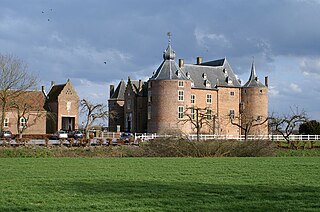
Ammersoyen Castle is located in Ammerzoden in the Bommelerwaard region in the province of Gelderland, the Netherlands. When the original construction of the castle occurred is unclear; some sources claim it was as early as the 12th century. However, the consensus among historians is that the Van Herlaer family completed the castle in the 1350s. At the time of its construction, the castle was built along a branch of the river Maas. Just a few years after the construction of the castle was completed, the river was rerouted leaving the castle to be surrounded by a moat.

Marjolein Hillegonda Monica Faber-van de Klashorst is a Dutch politician for the right-wing populist Party for Freedom (PVV), who has served as Minister of Asylum and Migration in the Schoof cabinet since July 2024. Previously, she was a member of the Provincial Council of Gelderland (2011–2023), of the Senate (2014–2023), and of the House of Representatives (2023–2024).
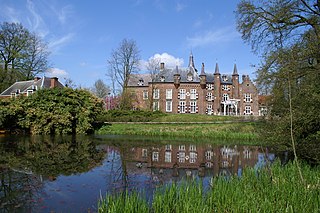
Maurick Castle is a castle in Vught, Netherlands. It had many famous owners and visitors.

Meerwijk Castle is a Tudor Revival Style mansion on the east bank of the Dieze river just north of 's-Hertogenbosch. It was preceded by Meerwijk Manor, built on the same location.

Waardenburg Castle, sometimes also called Weerdenburg, is a medieval castle located in Waardenburg in the municipality of West Betuwe, in the Dutch province of Gelderland.

Aldendriel Castle is late medieval castle in Mill, North-Brabant, Netherlands
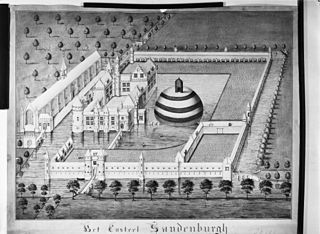
Zandenburg was a famous castle just south of Veere. Nothing remains of it, except some foundations below ground level.

Midwolde is a village in the municipality of Westerkwartier in the province of Groningen in the Netherlands. As of 2021, it had a population of 185. It is located just to the northeast of Leek.
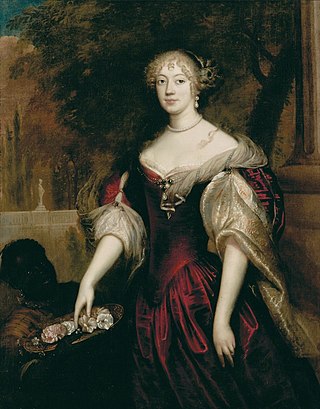
Anna van Ewsum was a rich Dutch noblewoman.
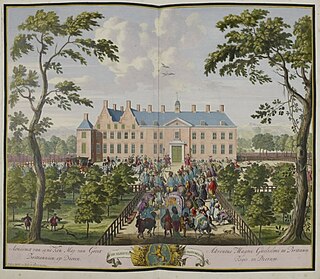
Hof te Dieren is a former hunting lodge in Dieren, the Netherlands. It was a favourite retreat of the princes of Orange and king-stadtholder William III at the south-eastern border of the Veluwe. Nothing remains of the lodge nor from the 19th century manor house which was built as replacement. The estate is open for visit.

Zevenhuizen is a village in the municipality of Westerkwartier in the province of Groningen in the Netherlands. As of 2021, it had a population of 2,725.

























